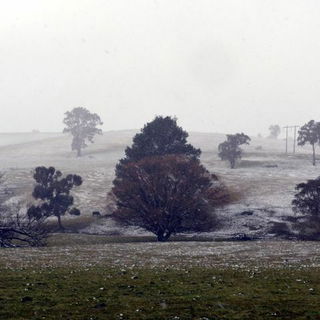The four seasons in Australia are: spring, summer, autumn, and winter. They determine the weather, the ecosystem, and daylight hours throughout the year.
What season is it in Australia? The current season in Australia is Winter.
Since Australia is located in the Southern Hemisphere, the seasons are opposite to those of the Northern Hemisphere.

When does each season start?
In 2025 - 2026, these are the astronomical dates for the start of each season in Australia:
- Autumn: Begins on Thursday, March 20,and ends on Saturday, June 21.
- Winter: Begins on Saturday, June 21 and ends on Tuesday, September 23.
- Spring: Begins on Tuesday, September 23,and ends on Monday, December 22.
- Summer: Begins on Monday, December 22,and ends on Thursday, March 20, 2026.
Although generally the climate of Australia is divided into four seasons, it is not the same throughout the country.
In the Northern top end of states, there are only wet and dry seasons because of the tropical climate.
Months of each season
To avoid confusion, many prefer to reference the meteorological seasons:
- Spring: September, October, November.
- Summer: December, January, February.
- Fall: March, April, May.
- Winter: June, July, August.
Spring
Spring in Australia covers the months of September, October, and November.
The beginning of spring corresponds to the spring equinox, which usually falls September 21st or 22nd in the Southern Hemisphere.
This season comes after the cooler winter months and before the arrival of summer, bringing with it a noticeable change in weather and daylight hours.
Spring is marked by gradually rising temperatures, blossoming landscapes, and longer days, making it a much-anticipated season for many Australians.
Read more about Spring in Australia.
Summer
Summer in Australia spans December, January, and February.
Summers are placed between spring and autumn in the Southern Hemisphere. Australian summers are known for its high temperatures and long daylight hours.
On one hand, the weather in coastal areas is typically warm and humid, and on the other hand, the inland and arid regions experience severely hot and dry seasons.
The first day of summer is marked by the summer solstice, which corresponds to the astronomical beginning of summer.
See also: Summer in Australia
Autumn
Autumn in Australia falls between summer and winter, covering the months of March, April, May, and June.
The first day of autumn is marked with the autumnal equinox. Autumn in Australia is defined by decreasing temperatures and a return of longer nights.
Summer's scorching heat gradually fades, giving way to cooler days and crisp mornings. Clear skies and low humidity are common during this season, making it ideal for outdoor activities and viewing the changing colors of deciduous trees in some areas.
Read more about Autumn in Australia.
Winter
Winter in Australia spans the months of June, July, and August, placing itself between autumn and the upcoming spring.
The winter solstice, which occurs around June 21st or 22nd, marks the astronomical start of winter.
Winters in Australia are known for their cooler temperatures and shorter daylight hours, as nights start getting longer again.
Unlike the Northern Hemisphere, where winter is accompanied by snow and frozen landscapes, Australian winters are milder, with snowfall limited to specific mountain ranges such as New South Wales' Snowy Mountains and the Australian Alps.
Winter in Australia is known for its cooler temperatures and shorter daylight hours, as the nights begin to lengthen again. The skies are usually clear with low humidity.
Read More About Winters in Australia
The Noongar Seasons
The Noongar seasons are followed by the Australian Aboriginal people, who are a group from the southwest region of Western Australia.
They categorize the climate into six different seasons, which is very different from the traditional four-season model used by European settlers.
They recognize the seasons by associating them with specific natural events and environmental changes.
These seasons play a very important role in the cultural and ecological knowledge of the Noongar people. The six seasons are as follows:
- Birak (December to January): It is typically referred to as the hot and dry season, characterized by high temperatures and little to no rainfall. Bushfires are a common occurrence during this time.
- Bunuru (February to March): During this time, it is slightly cooler but sometimes warm.
- Djeran (April to May): This month is marked by the arrival of autumn when the temperature is more moderate.
- Makuru (June to July): This is the season of cold and wet weather, with an increase in rainfall.
- Djilba (August to September): It is a pleasant season, associated with the arrival of the first wildflowers and the migration of birds.
- Kambarang (October to November): The warmer days begin and the wildflowers continue to bloom during this time.
The Climatic Diversity Of Australia
Coastal Zones
Australia has an extensive coastline that causes variations in climates in different regions. The northern coastal regions are determined by the warm waters of the Indian Ocean and Coral Sea, causing tropical and humid weather conditions. Whereas, the southern coastlines experience relatively milder climates with cooler sea breeze and moderate temperate conditions.
Wetlands and Tropical Rainforests
In the northern parts of Queensland, including the Daintree Rainforest, the weather is characterized by the presence of tropical rainforests. These regions receive high rainfall throughout the year, leading to a gloomy season.
Cyclone Regions
Northern Australia, especially the far north of Western Australia and the Northern Territory, is severely vulnerable to tropical cyclones during the rainy season. Events like these can bring strong winds, tremendous rainfall, and flooding.
Desert Regions
Some of the most popular deserts in the world are found in Australia, including the Simpson Desert, the Gibson Desert, and the Great Victoria Desert. As a result, these areas receive tremendously low amounts of rainfall, and the temperatures can be extremely hot during the day and cool during the night.
Highland Areas
With its rugged terrain, Tasmania has a cool temperate climate with high rainfall and milder temperatures than the rest of Australia. This region is well-known for its lush forests, picturesque lakes, and diverse wildlife.
Island Territories
Australia has several external territories, including Norfolk Island, Christmas Island, and the Cocos (Keeling) Islands, each with its climate, which is frequently influenced by their remote locations in the Indian and Pacific Oceans.
Coastal Barrier Reefs
Situated off the northeastern coast of Queensland, the Great Barrier Reef stands as one of the planet's most popular coral reef systems. This area has a tropical climate, so a lot of people like to snorkel and dive in its waters.











